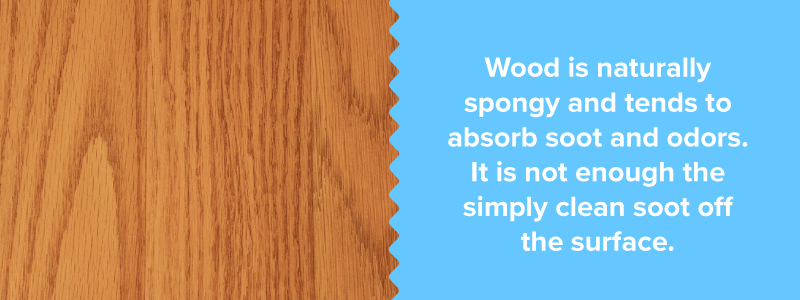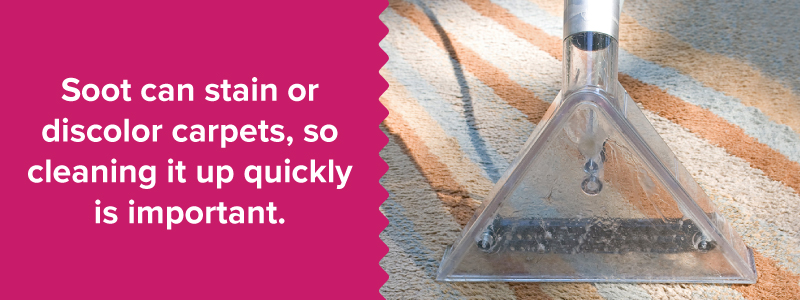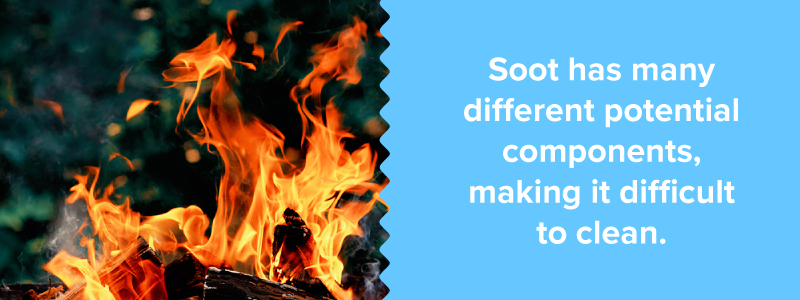How To Clean Soot After A Fire
Fire is a particularly destructive force that destroys property and burns many materials beyond repair. Whether the fire damage was caused by a wildfire, an electrical fire or a backyard barbecue that got out of control, the results can be devastating.Cleanup may involve repairing or replacing most surfaces in the building. Anything that wasn’t damaged by the fire might have been saturated beyond repair by firefighting attempts.Reading: how to remove sootBeyond that, the building and its contents may be soiled by smoke and soot as well.
What Is Soot?
Contents
Soot is what is left of the solid materials that were consumed in the blaze. Soot can be powdery and flaky depending on the contents of the burned materials.The carbon left behind when hydrocarbons burn are the tiny particles that make up soot. Soot is a byproduct of incomplete combustion.If you are familiar with old electric baseboard heaters, you have probably seen the black stains above them on the wall. These stains are caused by soot and means those heaters were not burning their fuel efficiently or completely.The contents of soot left behind from a fire depends on the type of fuel that burned in the fire. Soot may contain acids and chemicals from building materials.Furnishings made of or coated with plastics can produce extremely noxious soot when they burn. Soot also may contain soils, metals and dust.During the restoration process, it is important to clean soot off any surfaces and out of the air after a fire. If any soot is allowed to remain on the surfaces in your house, it will continue to stain and can be distributed into the air. The tiny particles of soot can cause serious health problems when inhaled.
How to Clean Different Surfaces Affected by Soot
Cleaning up soot begins with identifying the type of surface you are dealing with. Not all surfaces can be cleaned using the same methods.Some materials are more porous than others, so the soot could sink in below the surface. Other materials may be damaged by chemical treatments, and your cleaning attempts may only make things worse.The first step to clean soot off any surface is to use a strong vacuum to remove loose particles. A vacuum with a HEPA filter is the best way to suck up soot and not redistribute it into the air.You could also use a lambswool duster depending on the size of the surface and the amount of dry soot. It is a good idea to do this while the air scrubbers are running onsite. These will help filter any soot particles from the air that float up from the surfaces you are cleaning.During this stage, stick to dry cleaning methods. Using wet cleaning at this point may smudge the soot into the surface, creating a deep black stain.When soot is dry, it can be removed easily. The vacuum should be held at least half an inch away from the surface to avoid marking the item.Many items can be cleaned after fire and soot damage, so your first concern should be deciding on the most efficient means of remediating your site. You want to be sure you have the staff to get this job done while handling the more important aspects of cleanup.Assessing the overall remediation job is essential for getting it done right. You need to prioritize which items need to be cleaned right away and which ones can wait. In general, you want to remove all of the dry and loose soot particles from the work site first and get the air scrubbers working right away. Small items can be removed to another location for cleaning and deep cleaning should only begin after the extensive vacuuming is complete.
How to Clean Soot Off of Wood
Wood is naturally spongy and tends to absorb soot and odors. It is not enough the simply clean soot off the surface. The wood also needs to be deodorized.
How to Clean Soot Off of Vinyl Siding
On vinyl siding, you can start with a pressure washer and a gentle degreaser to begin cleaning the soot off. However, soot can permanently change the color of vinyl. If your siding has become permanently stained by soot, replacement might be the only option.Read more: How to control a wild kayakBefore you take such a drastic action, try cleaning with a pressure washer to see if you can get a uniform color over the entire house.You may also try to clean the vinyl siding by hand depending on how large the affected area is. Be careful not to use a stiff brush that could damage the vinyl.Automotive polishing, rubbing mix or plastic resin cleaner may work to remove the soot stains from the vinyl siding on the outside of the building.
How to Clean Soot from Hard Surfaces
Soot cleaning procedures work best on hard surfaces that have not been damaged by fire for too long. When the soot remains uncleaned for five days or more, the chances of removing all of the stains are slim.Hard-surface flooring, countertops and walls may be cleaned if you get to them right away. Plastic surfaces or items made from materials that contain plastics are almost impossible to clean. You might need to replace these items.To clean hard surfaces such as countertops and floors, you will need water and a specialized cleaner – Be sure to pay attention to manufacturer instructions for mixing if you buy a concentrated cleaner and dilute it yourself.Spray the cleaner on before wiping and rinsing with clean water. Take special note of which surfaces are not water-resistant, since these surfaces may not survive this type of cleaning. Use good judgment in determining which hard surfaces you will try to clean and which you may replace.
How to Clean Soot-Covered Furniture
Fabric-covered furniture can hold onto odors from fire and smoke for a long time. If left untreated, this furniture will release these odors into the air and contaminate the whole room.If the cushion covers are removable, the best solution is to take them off and launder them. The remaining upholstery can be cleaned with baking soda and a vacuum.Sprinkle baking soda on the fabric surface and let it sit for 24 hours. Remove the baking soda with a vacuum and the odor should go with it. You may need to repeat this process more than once to clean the soot off the furniture completely.Leather furniture requires a different method. Even if the seat cushions come off, they cannot be laundered, since leather should never be allowed to get too wet.Leather is easily scratched, too, so no abrasive cleaners or brushes can be used. Instead, use a soft cloth and some leather soap after vacuuming the loose soot off the surface.
How to Clean Soot from Carpet
Soot can stain or discolor carpets, so cleaning it up quickly is important. The dry soot can be easily removed with a HEPA vacuum.A synthetic carpet can be shampooed and dried thoroughly to remove any soot that set in or is oily and sticks to the carpet fibers. You might also find a steam cleaning system beneficial for pulling dirt and soot back out of the carpet.
Cleaning Mattresses after a Fire
Mattresses can often be cleaned after a fire if they have only minimal soot damage. Most of the damage will be on the surface of the mattress and the odor will be absorbed in the fabric covering. If the soot is not allowed to sit too long on the mattress, there is less likely to be significant permanent damage or odor.Vacuuming the soot off is the first step in mattress cleaning. Remember not to allow the vacuum to touch the mattress or it may leave marks.A strong vacuum with a HEPA filter will pull the soot particles off the surface of the mattress and may penetrate into the second layer.Surface soot stains on the mattress should be scrubbed with an appropriate cleaner. Scrub with a nylon brush to remove the stain and avoid applying too much soap or water. You will need an extractor to pull the soap and water out of the mattress and it can be dried with an air mover.Deodorizing the mattress can be done in a tented area or ozone vault for 24 to 48 hours. Spraying a deodorizer directly on the mattress and letting it dry is the final step.
How to Clean Soot from Lampshades and Wall Hangings
Lampshades and wall hangings are some of the most sensitive items to clean. Vacuuming and other dry cleaning methods are the best solutions. A blower could be used to remove excess soot particles if you have a concentrated air source.Be sure to clean the inside and outside of lampshades as well as the back and front of wall hangings. The goal is not only to make these items look good again, but also to remove the soot particles that can cause odors and pollute the air. A horsehair brush or a dry cleaning sponge may be helpful. You may also be able to spray the items with a fine mist of warm water and then vacuum the water off.
How to Clean Books after a Fire
Books can be damaged by mold and soot following a fire and need to be inspected before cleaning. The value of most books makes it more cost-effective for the insurance company to replace them than to clean them.Cleaning soot from books can involve holding them over air scrubbers to pull soot and mold spores out of the pages.The dust jacket should be discarded. The front and back covers can be cleaned with a wall cleaner and rags. Use a vice or clamp to hold the book closed and use sandpaper on the edge of the pages. This removes the edge of the soot-stained paper, assuming the soot did not penetrate the pages.Finally, deodorize books with a mist of solvent-based deodorant on the inside pages.
Common Mistakes Professionals Make With Soot
Read more: how to make a shark tooth necklaceEven professionals can make costly mistakes when they are not properly trained in removing soot and remediation for fire damage. These are some of the common errors you want to avoid:
Soot can make a dirty mess. Your inclination might be to wash it away with plenty of soap and water — especially if the soot is very oily. However, too much water can damage the carpet or leave it prone to growing mold.Carpet shampoo can leave a residue that attracts dirt. If you use too much shampoo and do not rinse it all out, the carpet will get dirty again quickly.When it comes to shampooing carpets to remove soot, less is more. Steam cleaning may be one of the most effective means of removing even the oiliest soot left behind by a fire. If you can get the job done without excess shampoo, you’ll enjoy better results.
The best way to remove soot from any surface is with a strong vacuum and HEPA filter. Most of the particles can be removed this way, leaving only small amounts of soot and stains to clean with soaps and polishes.If you do not remove all of the loose soot with a vacuum, the other methods of cleaning will rub it in and make it harder to remove.The biggest problem with vacuuming soot is finding the right equipment. Not all vacuums can do this job. You need to have a commercial vacuum with a HEPA filter specifically designed for this type of application. An air scrubber will help trap any soot particles released into the air during vacuuming.Without an air scrubber, you will vacuum the soot, blow it into the air and then have it settle back down on the surfaces you are attempting to clean.
When cleaning soot, you have to match the cleaner to the type of material you intend to clean. Soot has many different potential components, making it difficult to clean.Most people are inclined to use the strongest cleaner to be sure all residue and stains are removed. Unfortunately, a cleaner that is not right for the surface you are cleaning can cause even more damage.
Most people know you need to wear protective gear when doing fire restoration work. The smell of burned materials is a sign there are various toxins and respiratory irritants in the air from the fire.Water damage causes mold while soot from smoke poses serious respiratory issues. A common problem with protective gear is knowing what type you need for each job.It is better to be over-protected than under-equipped. OSHA sets strict guidelines for the use of protective gear that should be followed. When working with airborne toxins like soot, do not forget to protect your eyes.Air movers are usually employed on restoration sites to work in conjunction with air scrubbers and to dry the surfaces being remediated. If a few tiny particles of soot blew into your eyes, the toxins contained in them might cause infections or other irritations.You also do not want to expose your skin to soot or any of the cleaners used in fire restoration. A sturdy pair of gloves and long sleeves can keep your skin from coming into contact with and possibly absorbing toxins from any of the substances on a worksite.Respirators are also important for any airborne toxins. A soot cleanup job is not worth getting sick or a long-term health condition.These common mistakes can cost big on a fire restoration job, but the proper training for you and your crew can help reduce your likelihood of committing one of them. The health and sof your staff and the profitability of the work could both be at stake.
Always Call a Professional for Soot Cleanup
Fire and soot damage can represent a serious loss to your home or business. In addition to the financial and material loss, it also causes some insecurities. In the aftermath of a fire, lives are turned upside down and businesses disrupted.Everyone wants to get cleaned up and back to normal as quickly as possible, which is why soot cleanup is not a good DIY project.Trying to clean up soot and other damage after a fire can actually increase your losses. Without the proper training and equipment, you will not be able to properly restore your property. The excess damage you cause by attempting to clean up soot incorrectly may be irreversible even by professionals.It is a good idea to call in a professional team of remediation and restoration specialists immediately to assess the damage and begin the cleanup.Soot cleanup is time-sensitive — the longer it waits, the more damage occurs. Soot also carries an unseen health risk. You may clean away all visible signs of soot and smoke damage, but there could be microscopic particles contained in your furniture, walls and even in the air.Over time, these particles will be released and could pose a respiratory risk to anyone in your home or office. Don’t take any unnecessary chances.Read more: How to unfollow on Amazon? | Top Q&A
Last, Wallx.net sent you details about the topic “How To Clean Soot After A Fire❤️️”.Hope with useful information that the article “How To Clean Soot After A Fire” It will help readers to be more interested in “How To Clean Soot After A Fire [ ❤️️❤️️ ]”.
Posts “How To Clean Soot After A Fire” posted by on 2021-09-14 10:18:55. Thank you for reading the article at wallx.net





